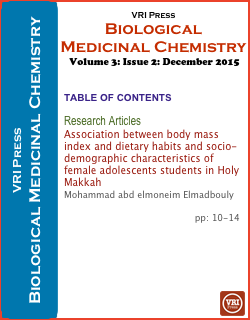
Association Between Body Mass Index and Dietary Habits and Socio-Demographic Characteristics of Female Adolescent Students in Holy Makkah
Abstract
Introduction: Nutritional needs during adolescence are increased because of the increased growth rate and changes in body composition associated with puberty. Eating habits vary widely between individual adolescents. Poor eating habits formed during adolescence can lead to obesity and diet-related diseases in later years. The aim of the study was to determine the socio-demographic factors, dietary habits and mean physical characteristics of the subjects associated with BMI. Subjects and methods: A descriptive approach, cross-sectional design was used to assess the dietary intake of adolescent girls with respect to healthy diets. 100 female students with age range of 16-19 years were included in the study. The study questionnaires was used to collect data about Socio-demographic factor, dietary habits,. Anthropometric measurements were done including weight, height, body mass index (BMI) and fat percent. Data analysis was carried out using the Statistical Package of the Social Science (SPSS) version 20. Result and discussion: These results indicated that there is a statistical significant association between BMI and vitamin/mineral supplementation (P< 0.05), 28% who were consuming them. In addition the findings showed that 41% of the female students who skipped breakfast meal had normal BMI. Our study revealed that there is no statistically significant relationship between BMI and physical exercise (P> 0.05) in 37% of adolescent girls who practiced physical exercise more than one time weekly. Also the data revealed that there is no statistically significant relationship (P>0.05) between BMI and breakfast, main meals and snacking. Conclusion: Our results show that almost half of the subjects have normal BMI. But there is not statistical significance relationship between BMI and socio-demographic characteristics, and dietary habits except for vitamin and mineral supplementation. Implementing educational programs which regarding the weight management and maintains adequate nutrient. To improve the dietary pattern and the nutritional status of female adolescents is recommended.
Keywords
References
Spear BA: Adolescent growth and development. Journal of the American Dietetic Association 2002, 102:S23-S29.
http://dx.doi.org/10.1016/S0002-8223(02)90418-9
McNaughton SA: Understanding the eating behaviors of adolescents: application of dietary patterns methodology to behavioral nutrition research. Journal of the American Dietetic Association 2011, 111:226-229.
http://dx.doi.org/10.1016/j.jada.2010.10.041
PMid:21272696
Vlismas K, Stavrinos V, Panagiotakos DB: Socio-economic status, dietary habits and health-related outcomes in various parts of the world: a review. Cent Eur J Public Health 2009, 17:55-63.
PMid:19662821
Organization WH: The world health report 2002: reducing risks, promoting healthy life: World Health Organization; 2002.
Brodney S, Mcpherson RS, Carpenter R, Welten D, Blair SN: Nutrient intake of physically fit and unfit men and women. Medicine and science in sports and exercise 2001, 33:459-467.
http://dx.doi.org/10.1097/00005768-200103000-00020
PMid:11252075
Boston RC, Moate PJ, Allison KC, Lundgren JD, Stunkard AJ: Modeling circadian rhythms of food intake by means of parametric deconvolution: results from studies of the night eating syndrome. The American journal of clinical nutrition 2008, 87:1672-1677.
PMid:18541555
Cho S, Dietrich M, Brown CJ, Clark CA, Block G: The effect of breakfast type on total daily energy intake and body mass index: results from the Third National Health and Nutrition Examination Survey (NHANES III). Journal of the American College of Nutrition 2003, 22:296-302.
http://dx.doi.org/10.1080/07315724.2003.10719307
PMid:12897044
Summerbell C, Moody R, Shanks J, Stock M, Geissler C: Relationship between feeding pattern and body mass index in 220 free-living people in four age groups. European Journal of Clinical Nutrition 1996, 50:513-519.
PMid:8863011
Tawfik S L: Food Consumption Patterns and Dietary HabitsAssociated with Weight Status in Healthy Young Adult Students. Al-Azhar University – Gaza. Edited by: Al-Azhar University – Gaza; 2011.
Sjöberg A, Hallberg L, Höglund D, Hulthén L: Meal pattern, food choice, nutrient intake and lifestyle factors in The Göteborg Adolescence Study. European journal of clinical nutrition 2003, 57:1569-1578.
http://dx.doi.org/10.1038/sj.ejcn.1601726
PMid:14647222
Isa KAM, Masuri MG: The association of breakfast consumption habit, snacking behavior and body mass index among university students. American Journal of Food and Nutrition 2011, 1:55-60.
http://dx.doi.org/10.5251/ajfn.2011.1.2.55.60
O'Brien G, Davies M: Nutrition knowledge and body mass index. Health education research 2007, 22:571-575.
http://dx.doi.org/10.1093/her/cyl119
PMid:17041019
Amini M, Rezvanian H, Gouya M-M, Delavari A, Alikhani S, Mahdavi A: Association of body mass index and abdominal obesity with marital status in adults. Archives of Iranian medicine 2008, 11:274-281.
PMid:18426318
Chen AY, Escarce JJ: Peer Reviewed: Family Structure and Childhood Obesity, Early Childhood Longitudinal Study—Kindergarten Cohort. Preventing chronic disease 2010, 7.
Wang Y: Cross-national comparison of childhood obesity: the epidemic and the relationship between obesity and socioeconomic status. International journal of epidemiology 2001, 30:1129-1136.
http://dx.doi.org/10.1093/ije/30.5.1129
PMid:11689534
Giugliano R, Carneiro EC: Factors associated with obesity in school children. Jornal de pediatria 2004, 80:17-22.
http://dx.doi.org/10.2223/1128
http://dx.doi.org/10.2223/JPED.1128
Crockett SJ, Sims LS: Environmental influences on children's eating. Journal of Nutrition Education 1995, 27:235-249.
http://dx.doi.org/10.1016/S0022-3182(12)80792-8
Stea TH, Wandel M, Mansoor MA, Uglem S, Frølich W: BMI, lipid profile, physical fitness and smoking habits of young male adults and the association with parental education. European journal of public health 2009, 19:46-51.
http://dx.doi.org/10.1093/eurpub/ckn122
PMid:19060328
Lamerz A, Kuepperâ€Nybelen J, Bruning N, Wehle C, Trostâ€Brinkhues G, Brenner H, Hebebrand J, Herpertzâ€Dahlmann B: Prevalence of obesity, binge eating, and night eating in a crossâ€sectional field survey of 6â€yearâ€old children and their parents in a German urban population. Journal of Child Psychology and Psychiatry 2005, 46:385-393.
http://dx.doi.org/10.1111/j.1469-7610.2004.00363.x
PMid:15819647
DOI: http://dx.doi.org/10.14259%2Fbmc.v3i2.175
Refbacks
- There are currently no refbacks.








